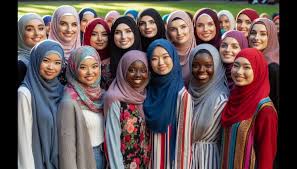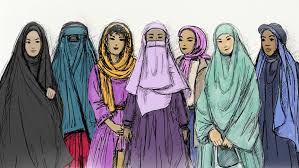The Meaning of Hijab in Muslim Culture: A More intensive Gander at Humility, Character, and Strengthening
In the rich embroidery of Islamic culture, the hijab stands apart as an image of humility, personality, and strengthening for Muslim ladies. Beyond its literal meaning of “covering” or “veil,” the hijab plays a significant role; a complex and nuanced articulation holds profound social and strict importance. The purpose of this article is to investigate the many facets of the hijab, including its historical origins, its function in fostering a sense of identity, and the empowerment it gives Muslim women.

The hijab, frequently misjudged as an image of mistreatment.
tracks down its underlying foundations in the lessons of Islam, where unobtrusiveness is exceptionally esteemed. Although modesty in dress is encouraged by Islam for both men and women, the hijab, which is only worn by women, has become a topic of debate. A long way from being a device of enslavement, the hijab is an individual and otherworldly decision for the vast majority Muslim ladies. It mirrors their obligation to submitting to the precepts of Islam and is viewed for the purpose of safeguarding oneself from the look of the other gender.
Essential to examine:
It Is essential to examine the historical context of the hijab in order to comprehend its significance. The act of veiling originates before Islam and can be followed back to different antiquated civilizations. In the Arabian Peninsula, the birthplace of Islam, covering one’s head was a sign of modesty and social status for women. At the point when Islam was presented, it embraced specific existing social practices while adjusting others. The Quran, the sacred book of Islam, contains stanzas accentuating humility and empowering adherents to bring down their look and defenses their unobtrusiveness. Over the long run, the hijab developed into a particular Islamic work on, setting its place in Muslim culture.
For the vast majority Muslim ladies,
wearing the hijab is a cognizant decision that goes past strict commitments. It fills in as a strong articulation of personality, a noticeable marker of their confidence and adherence to Islamic standards. In a world portrayed by social variety, the hijab turns into a binding together component among Muslim ladies, cultivating a feeling of local area and sisterhood. It creates a shared identity that unites women from diverse backgrounds across national and ethnic lines. The hijab turns into an assertion, declaring one’s obligation to confidence and giving a noticeable portrayal of Islam in an undeniably globalized world.
Pundits contend that the hijab confines a lady’s opportunity and propagates orientation disparity.
In any case, numerous Muslim ladies view it as a wellspring of strengthening, empowering them to recover command over their bodies and challenge cultural standards. The hijab moves the concentration from actual appearance to scholarly abilities, character, and accomplishments. Women challenge stereotypes that depict them as merely desirable objects by opting to wear the hijab and demonstrating their independence. In a world that frequently focuses on shallow norms of excellence, the hijab turns into a method for opposing externalization and stating one’s inward strength.
Besides, the hijab enables Muslim ladies by permitting them to characterize their story.
It gives a stage to self-articulation inside the limits of confidence, permitting ladies to make a statementIn the different embroidery of human societies, Islam stands apart as an energetic and complex custom. Integral to the statement of Islamic personality is the hijab, an image that reaches out past a simple piece of material to exemplify a significant association between confidence, culture, and cultural qualities. This article examines the significance of the hijab in Muslim culture, tracing its origins back to Islamic teachings, the spiritual significance it carries for Muslim women, and its larger influence on societal norms.
Authentic and Strict Roots:
The starting points of the hijab can be followed back to the Quran, the sacred book of Islam, and the lessons of Prophet Muhammad (harmony arrive). The Quran underlines humility and teaches all kinds of people to bring down their look and defenses their virtue. The hijab, as an actual sign of this unobtrusiveness, is viewed for the purpose of maintaining the upsides of devotion and modesty recommended in Islam. It fills in as a sign of the significance of sticking to the standards spread out in the Quran, encouraging a more profound association between the individual and their confidence.
Spirituality’s Importance:
For Muslim ladies, wearing the hijab goes past simple adherence to strict regulation; it turns into a profoundly private and otherworldly decision. The hijab is viewed as a type of love, a method for communicating dedication to Allah and a promise to carrying on with a daily existence as per Islamic standards. The demonstration of wearing the hijab is a cognizant choice to adjust one’s outer appearance to one’s inner convictions, making an agreeable connection between the otherworldly and the actual parts of a singular’s personality.
Social Personality and Variety:
The hijab fills in as a strong image of social personality inside the Muslim world. Across different districts and networks, the style and shade of the hijab might shift, mirroring the rich variety inborn in Muslim societies. It turns into an unmistakable articulation of one’s social legacy while at the same time joining Muslim ladies under a typical flag of shared values and convictions. In this setting, the hijab is a cultural symbol that changes over time and can be adapted to accommodate a variety of faith interpretations and expressions.
Choice-Based Empowerment:
As opposed to misguided judgments, the hijab isn’t an image of persecution, yet rather a wellspring of strengthening for the overwhelming majority Muslim ladies. The decision to wear the hijab is very much a personal one, and for many women, it is a conscious decision to control their own story. It gives a feeling of organization and independence, permitting Muslim ladies to characterize their personality based on their conditions and challenge cultural standards that might look to force limitations. The hijab turns into a vehicle for self-articulation and a dismissal of externalization, empowering Muslim ladies to be seen and heard past shallow generalizations.
Cultural Effect and Discernments:
In social orders where Islam is a minority or misjudged, the hijab frequently turns into a point of convergence for conversations encompassing strict opportunity and social variety. The perceivability of Muslim ladies wearing the hijab challenges assumptions and advances discourse, encouraging a superior comprehension of Islam and its social subtleties. Be that as it may, the hijab likewise faces difficulties in social orders where misinterpretations continue, prompting segregation and bias against the people who decide to wear it. Regardless of these difficulties, the hijab stands versatile as an image of strict opportunity and social articulation.

Woman’s rights and the Hijab:
The convergence of woman’s rights and the hijab is a complex and nuanced subject. While some contend that the hijab is contradictory to women’s activist standards, others battle that it very well may be an integral asset for women’s activist articulation. Muslim ladies who decide to wear the hijab affirm that their choice is established in independence and individual organization, lining up with women’s activist standards of self-assurance. The hijab challenges ordinary Western ideas of woman’s rights, welcoming a more extensive discussion about the variety of women’s activist encounters and the significance of social responsiveness in women’s activist talk.
Difficulties and Confusions:
Regardless of the rich embroidery of implications woven into the hijab, it isn’t insusceptible to difficulties and confusions. In certain social orders, authoritative endeavors to boycott the hijab openly spaces have been met with opposition from Muslim people group, who contend that such measures encroach upon strict opportunity. Also, generalizations partner the hijab exclusively with mistreatment persevere, disregarding the variety of voices inside the Muslim people group and the fluctuated reasons ladies decide to wear the hijab. The significance of the hijab in Muslim culture stretches out a long ways past its visible presentation; it embodies a complicated exchange of strict dedication, social personality, and individual strengthening. For Muslim ladies, the hijab is an honest strong image and a statement of individual organization, testing cultural standards and encouraging discourse. Understanding the multifaceted significance of the hijab becomes crucial for promoting inclusivity and respect for different expressions of identity within the global community as societies continue to grapple with issues of cultural diversity and religious freedom.


You must be logged in to post a comment.